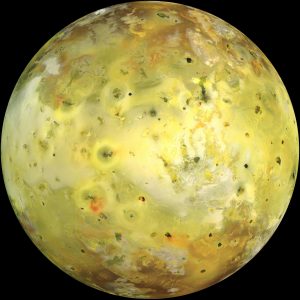
Io is the third largest moon of Jupiter, and the most volcanically active body in our solar system.
Io is one of the Galilean moons, the four largest of Jupiter’s satellites, named after their discoverer Galileo Galilei, who first trained his telescope on Jupiter in 1609.
Io’s mean radius is around 1,821 km, just slightly smaller than our own Moon.
NASA’s Voyager spacecraft visited Io in 1979, revealing Io’s vulcanism for the first time. This activity is caused by tidal forces, due to Io’s proximity to Jupiter. These forces push and pull on the moon as it orbits, causing its interior to heat up and the moon itself to take on a slightly elliptic shape stretching out towards Jupiter.
This activity has covered Io’s surface in sulphur and sulphur dioxide, giving it an overall yellow complexion, although various allotropes and compounds of sulphur colour the surface with patches of reds, whites , blacks, and greens.
NASA’s Galileo mission to Jupiter also visited Io with several close flybys between 1995 and 2002, and the New Horizons probe imaged the moon on its way to Pluto in 2007.